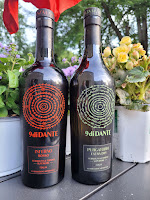9diDANTE comes to life as a modern liquid version of the poem (Comedìa). To us, Vermouth is a power struggle between Wormwood and all the other botanicals, told in a language that everyone can understand … wine! -- Alex Ouziel
 Vermouth has been a popular topic within our community particularly after receiving samples of the Dante inspired 9diDANTE. The brand was created by Alex Ouziel in collaboration with Mario Baralis (ex-Carpano -- the father distillery of Italian vermouth). Their vermouth is produced at the historic Dr. M. Montanaro Distillery (1885) in Piedmont and they are one of a few producers in the Turin region to use 100% DOC Piedmontese wines, made entirely from native grapes -- Dolcetto/Cortese for the red Inferno and Arneis for the extra dry Purgatorio. Each vermouth contains 27 botanicals with the major contributors aligning to Dante's classical interpretation of the nine levels within each of the three cantiche – Inferno (Hell), Purgatorio (Purgatory), and Paradiso (Paradise)*. Thus three cantiche multiplied by nine levels = 27 botanicals.
Vermouth has been a popular topic within our community particularly after receiving samples of the Dante inspired 9diDANTE. The brand was created by Alex Ouziel in collaboration with Mario Baralis (ex-Carpano -- the father distillery of Italian vermouth). Their vermouth is produced at the historic Dr. M. Montanaro Distillery (1885) in Piedmont and they are one of a few producers in the Turin region to use 100% DOC Piedmontese wines, made entirely from native grapes -- Dolcetto/Cortese for the red Inferno and Arneis for the extra dry Purgatorio. Each vermouth contains 27 botanicals with the major contributors aligning to Dante's classical interpretation of the nine levels within each of the three cantiche – Inferno (Hell), Purgatorio (Purgatory), and Paradiso (Paradise)*. Thus three cantiche multiplied by nine levels = 27 botanicals.  The vermouth is produced within the Vermouth di Torino Superiore IGP - a classification created in 2019 to guarantee the quality of its origin and process. According to the Consortium, "World-renowned for the tradition and historicity of its production, Vermouth di Torino is an aromatized wine born in the 18th century at the foot of the Alps and enjoyed at the court of the Savoy kings. Vermouth di Torino is known worldwide for the tradition and history of production. The fame of Vermouth di Torino PGI is inextricably linked to Piedmont producers and Turin. In the 1800s, Turin was home to the aristocracy of vermouth makers, thanks to whom, in different ways and to different degrees, Vermouth di Torino achieved international standing and became appreciated worldwide. Over the years, techniques and processes have evolved: new ideas went hand in hand with the older practices, and they continue to coexist today, preserving and valorizing Vermouth di Torino's traditional production. Vermouth di Torino is classified according to the color (White, Amber, Rosé or Red) and the amount of sugar used in its preparation". As one of only a few Vermouths crafted and bottled under the Superiore classification, 9diDANTE goes well beyond the consortium's regulations. Whereas a Superiore vermouth must use at least 50% Piedmont wines, 9diDANTE uses 100%. Whereas Superiore vermouth must be produced and packaged locally, 9diDANTE sources the actual packaging locally. And whereas Superiore vermouth must be at least 75% wine content, 9diDANTE has 84% wine content.
The vermouth is produced within the Vermouth di Torino Superiore IGP - a classification created in 2019 to guarantee the quality of its origin and process. According to the Consortium, "World-renowned for the tradition and historicity of its production, Vermouth di Torino is an aromatized wine born in the 18th century at the foot of the Alps and enjoyed at the court of the Savoy kings. Vermouth di Torino is known worldwide for the tradition and history of production. The fame of Vermouth di Torino PGI is inextricably linked to Piedmont producers and Turin. In the 1800s, Turin was home to the aristocracy of vermouth makers, thanks to whom, in different ways and to different degrees, Vermouth di Torino achieved international standing and became appreciated worldwide. Over the years, techniques and processes have evolved: new ideas went hand in hand with the older practices, and they continue to coexist today, preserving and valorizing Vermouth di Torino's traditional production. Vermouth di Torino is classified according to the color (White, Amber, Rosé or Red) and the amount of sugar used in its preparation". As one of only a few Vermouths crafted and bottled under the Superiore classification, 9diDANTE goes well beyond the consortium's regulations. Whereas a Superiore vermouth must use at least 50% Piedmont wines, 9diDANTE uses 100%. Whereas Superiore vermouth must be produced and packaged locally, 9diDANTE sources the actual packaging locally. And whereas Superiore vermouth must be at least 75% wine content, 9diDANTE has 84% wine content. * For those who would like to learn about the epic poem I recommend the Hillsdale College course or the Word On Fire seminar.






